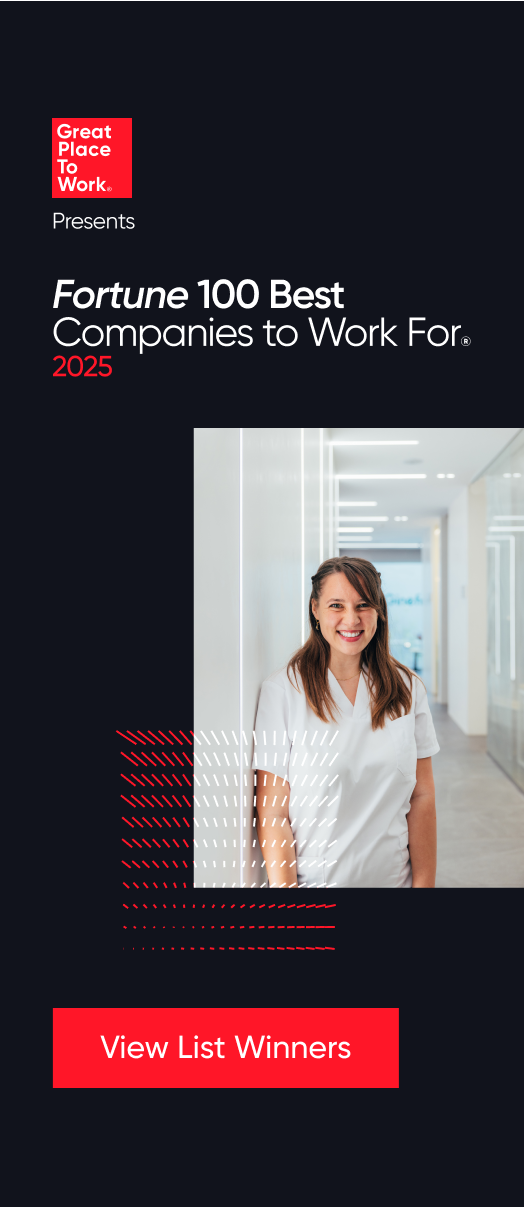
There are certain areas where, practically speaking, great workplaces stand out head and shoulders above the rest. What are these areas, and why is it important that your organization focus on them?
Great Place To Work invites companies to tell us about their company through the Culture Audit, a proprietary tool designed for companies to showcase their stories about how they create a great workplace for their employees.
After analyzing responses to the Culture Audit for more than two decades, we know which areas are critical to building an employee experience characterized by trust, pride, and camaraderie – in other words, the pillars of a great workplace culture. Investing time and energy into developing these areas will help organizations streamline focus, and maximize impact, towards developing a workplace that employees would characterize as a great one.
What are the areas, and why are they important?
Hiring: What characteristics do you look for in new employees?
Why it matters: Because companies that care about their cultures are extraordinarily selective in who they hire, and attend to a candidate's skill set and culture fit. Hiring practices will include opportunities to engage the candidate with many different people in the company, and clearly tie in with the organization's culture, values, and mission.
Example: As a part of their extensive hiring process, Baptist Health South Florida uses a custom behavioral assessment tool. The behavioral assessment looks at candidates in comparison to profiles of existing high-performing employees at Baptist. Developing these profiles is an inclusive process, involving both employees and leaders alike.
Welcoming: How do you welcome new employees and integrate them into your culture?
Why it matters: Because great workplaces use distinct and varied methods of giving all new hires a warm welcome, integrating them into the culture from Day One.
Example: At consulting firm Kimley-Horn, before a new employee even sets foot in the office for their first day, they are greeted with a welcome email, calls from their team, and a letter from the president, thanking them for joining the firm. These communications set the tone for the welcome they receive on the first day in the office. Spouses/domestic partners are included, too—all new hires with partners receive an orientation packet for their spouse, which includes a certificate for $125, redeemable for dinner with another Kimley-Horn couple of their choice.
Inspiring: How do you inspire employees to feel that their work has meaning?
Why it matters: Because at organizations with great cultures, employees feel connected to a shared purpose when they come to work each day. Programs are in place that help foster pride, and show employees the value of their work for customers and for society overall.
Example: In KPMG's "Higher Purpose Initiative," associates submit stories demonstrating how, through their work at KPMG, they have made a positive difference in the world. Stories are shared using electronic, print, video, and social media.
Speaking: What are distinctive ways senior management shares information, including bad news?
Why it matters: Because leaders at great workplaces understand the important role that sharing information plays in maintaining a trust-based relationship with employees. Transparency, accessibility and warmth are all aspects we see incorporated into information sharing at the Best.
Example: To help share information with frontline employees, executives at hospital system Southern Ohio Medical Center visit their business areas in scheduled quarterly meetings to meet with employees of that department. They review current financial information, new services, quality metrics and answer questions.
Listening - Upward Communication: How can employees ask questions, provide feedback, or otherwise communicate with managers, especially senior managers?
Why it matters: Because just as being informed is an important component of trust-building, so is offering employees the opportunity to ask questions of leaders. Organizations scoring highly on this question demonstrate a sincere interest in hearing employee feedback, and offer a variety of methods for doing so.
Example: JM Family Enterprises hosts "Ask Me Anything" sessions on their intranet, an opportunity to facilitate a Q&A between one or more hosts and an online audience, whether it’s the entire organization or a targeted work group. During these events, a senior leader, subject matter expert or other engaging speaker hosts an open forum for associates to ask questions in an informal setting. Questions can be about any topic from favorite books and sports teams to organizational excellence and insight on challenges facing the industry.
Listening – Collaborating/Innovation: How do you encourage all employees to share new ideas and better ways of doing things? How have these efforts have translated into positive improvements and innovations for your business and people?
Why it matters: Because tapping into the insights of employees, particularly those that work on the front line, helps create an Innovation by All culture, where employees feel motivated and inspired to come up with the next great idea that will benefit the organization and its bottom line.
Example: Technology company Alliance Data's associate engagement committee hosts monthly Feedback Fridays, where they invite associates to drop by and talk about what’s working — and what’s not. Feedback Fridays are opportunities for associates to talk about their work environment, systems and processes, and other aspects of the workplace that they feel could use improvement. The engagement committee members set up in the company's on-site café, and associates can stop by to share their ideas or learn more about what’s happening at Alliance Data.
Thanking: How does your company show appreciation and/or recognition for employees' good work and extra effort, or other achievements?
Why it matters: Because when employees are appreciated for their work, they know that they are valued and respected as an important part of the organization. Great workplaces embrace a culture of appreciation, and offer a variety of programs that give all employees that opportunity to be frequently recognized.
Example: Retailer Burlington Stores, Inc. publicly recognizes its associates for a job well done on their social media pages in their #MentionMonday posts, highlighting frontline employees for their contributions and achievements, such as a promotion or going above and beyond on the job.
Developing: How does your company help employees discover and develop their talents, challenge themselves professionally, manage their careers, and/or enhance their personal growth?
Why it matters: Because when leaders value their employees as a critical part of the company's success, they treat training and development as a top priority. Great workplaces foster a culture of learning, and provide all employees a variety of channels to further both their professional growth and personal interests.
Example: Biotechnology company Genentech believes that cross-functional job rotations provide employees valuable hands-on experience in another part of the business. Their gHERO program is one example of a rotation program. Managers with needs on their teams post project descriptions to the gHERO website. The rotations are generally part time for six months, though the duration can vary depending on the project.
Caring - Balancing: In what distinctive ways does your company help employees balance their work lives with their personal and/or family lives? How do you support employees during significant live events (such as a personal crisis, family illness, birth, marriage, etc.)?
Why it matters: Because great workplaces make it clear that they care for employees as full human beings—not just as employees. These organizations provide a range of work/life benefits and programs that all employees have access to, and that support a wide variety of individual needs.
Example: Every month, accounting and professional services firm Plante Moran uses their intranet to feature staff members discussing how they find work-life-balance and any advice they have learned on their career journey. These profiles are presented in various formats, including WorkFlex audits, where staff answer questions such as how their balance has changed over the years, something that might surprise others about how they find balance, and three tips they use to stay balanced. Short articles featuring a unique angle about work-life balance are also shared.
Caring - Including: How do you ensure you are creating a great workplace for all employees regardless of their personal backgrounds and place in the organization? Do you have programs and/or policies intended to promote diversity and/or inclusion across personal demographics and job roles?
Why it matters: Because truly great workplaces are great for everyone who works there, showcasing a variety of programs and practices that foster a diverse workforce and promote inclusion at all levels.
Example: To ensure fairness in the performance review process, hundreds of trained "inclusiveness champions" at professional services firm EY take part in annual performance evaluation meetings, listening for unintended bias in performance-rating discussions. When irrelevant or ill-defined considerations arise, the inclusiveness champions steer the conversation toward objective evaluation criteria, focusing on outcomes rather than style.
Celebrating: How do you encourage fun and camaraderie among your employees?
Why We Ask: Because great workplaces understand that camaraderie and fun are essential to great culture, and find many excuses to have fun and celebrate.
Example: To encourage fun and camaraderie in small, simple ways, employees in lender Veterans United Home Loans' people services division decided to celebrate employee birthdays with a tailored 15-minute party. Each person’s party was unique to something they are passionate about and required little or no budget. The first party was a comedy club party where everyone came with a joke for the employee who was celebrating her birthday. Another party was an art show where everyone submitted a meme to display and the birthday girl picked her favorite to hang in her work area.
Sharing - Rewards: What is your company's approach to financially compensating employees? What are the methods used to determine levels of compensation? Do you have unique or special forms of compensation (i.e. profit sharing, bonuses, etc.)? What policies and/or practices do you have that promote a sense of equity between employees and managers?
Why it matters: Because great workplaces focus efforts on ensuring that their compensation-related activities are fair, well-communicated, and inclusive.
Example: Each spring, car retailer CarMax creates a personalized total rewards statement for every single associate. It shows each person what the company has invested in them over the past year, including pay, stock, the company’s contributions for their elected benefits, paid time-off benefits, and more. It’s accompanied by a 16-page Guide for Personal Success that helps associates see the value of employment at CarMax — from compensation to benefits to work/life balance and career development. The guide shares information about all the programs available to help associates be successful in their personal and professional goals and is easily accessible online.
Sharing - Community: What are your organization's philanthropic, environmental, or other corporate social responsibility initiatives, and how do employees participate in and/or derive value from these efforts?
Why it matters: Because great workplaces demonstrate a sense of care that extends beyond their immediate workforce and customers. Such organizations have a variety of philanthropic programs and practices that they actively encourage employees to participate in, and that often tie into the mission and values of the company.
Example: As part of their Military Appreciation Month celebration, employees at Navy Federal Credit Union send thank you notes to servicemen and women.
Leadership Effectiveness: What is your executive team’s current short and long-term strategy and philosophy for ensuring a successful business? What was the process for developing it, and how was it communicated across all levels of the business?
Why it matters: It’s not enough to have a solid strategy to ensure business success – great workplaces also involve employees in developing this strategy, and make a conscious effort to reinforce the strategy across all lines of business, ensuring employees can connect their daily work to the overarching goals of the organization, which makes them feel valued and inspired.
Example: Employees at analytics company SAS Institute voiced a need for more information from executives, so their COO has created the monthly COO Report email to keep everyone globally in the know. This report provides details, insights and updates relevant to the company’s success and achievements overall and specific to the key components of their three-year plan. It builds off the high-level information and interviews held quarterly by the CEO to ensure that each employee can track and be aligned to the company’s priorities and progress. SAS says this report connects the dots to the various initiatives and activities leaders across the business are launching in response to employee and customer insights.
These areas we’ve highlighted are foundational in creating best workplaces where employees thrive and feel cared for.











